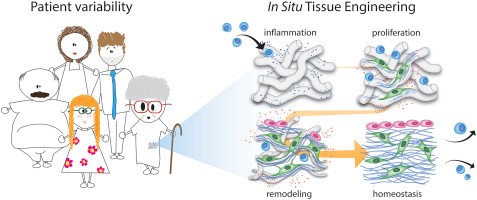
Description
Within the in situ tissue engineering approach the aim is to induce endogenous regeneration of cardiovascular tissues by using synthetic, off-the-shelf-available and biodegradable grafts. Upon implantation host immune cells will infiltrate the graft and regulate down-stream remodeling processes. Especially macrophages are thought to be one of the key regulators in the in situ response and their interplay with (myo)fibroblasts is essential for steering towards functional tissue formation. Although this approach heavily relies on the intrinsic regenerative capacity of the human body, patient-specific characteristics, such as sex and age, are rarely taken into account. 1
Interestingly, the prevalence and manifestation of cardiovascular diseases as well as immunological pathologies are different between males and females. 2,3,4 One possible cause for these differences could be the influence of sex hormones, especially estrogen. Estrogen is thought to have a cardioprotective effect. In female mice a causal relation between estrogen and arterial stiffness was found, which was independent of cholesterol.7 Moreover, estrogen is known to steer the macrophage polarization towards the anti-inflammatory, pro-healing phenotype, 8,9 necessary for functional tissue formation and prevention of scar tissue formation.
The aim of this project is to gain insight in the influence of the patient-specific characteristics sex and age on the material-driven in situ regenerative processes. More specifically, the effects of estrogen on the initial macrophage response to a degradable cardiovascular graft and the macrophage-guided tissue regeneration in such grafts will be studied. A humanized in vitro setup will be used to mimic both physiological hemodynamical loading and patient-specific hormone levels. In addition, an in vivo animal study will be conducted to study the effect of hormones on downstream cardiovascular remodeling.
References
1. Smits, A. I. P. M. & Bouten, C. V. C. ScienceDirect Tissue engineering meets immunoengineering : Prospective on personalized in situ tissue engineering strategies. Curr. Opin. Biomed. Eng. 6, 17–26 (2018).
2. Simard, L. et al. Sex-Related Discordance Between Aortic Valve Calcification and Hemodynamic Severity of Aortic Stenosis Is Valvular Fibrosis the Explanation ? 681–691 (2016). doi:10.1161/CIRCRESAHA.116.309306
3. Villard, C., Eriksson, P., Swedenborg, J. & Hultgren, R. Differences in Elastin and Elastolytic Enzymes between Men and Women with Abdominal Aortic Aneurysm. Aorta 2, 179–185 (2014).
4. Kallen, A. N. & Pal, L. Cardiovascular disease and ovarian function. (2011). doi:10.1097/GCO.0b013e3283488a21
5. Masjedi, S., Lei, Y., Patel, J. & Ferdous, Z. Sex-related differences in matrix remodeling and early osteogenic markers in aortic valvular interstitial cells. Heart Vessels 32, 217–228 (2017).
6. Aggarwal, S. R. et al. Sex Differences in Aortic Valve Calcification Measured by Multidetector Computed Tomography in Aortic Stenosis. 40–47 (2013). doi:10.1161/CIRCIMAGING.112.980052
7. Liu, S. et al. Cardiovascular protection in females linked to estrogen-dependent inhibition of arterial stiffening and macrophage MMP12. JCI Insight 4, (2019).
8. Toniolo, A. et al. Alternative Activation of Human Macrophages Is Rescued by Estrogen Treatment In Vitro and Impaired by Menopausal Status. J. Clin. Endocrinol. Metab. 100, E50–E58 (2015).
9. Villa, A., Rizzi, N., Vegeto, E., Ciana, P. & Maggi, A. Estrogen accelerates the resolution of inflammation in macrophagic cells. Sci. Rep. 5, 1–14 (2015).
Researchers
Researcher: B.J. (Bente) de Kort
Supervisors: A.I.P.M. (Anthal) Smits, C.V.C. (Carlijn) Bouten
We gratefully acknowledge the financial support by the Ministry of Education, Culture and Science (Gravitation Program 024.003.013).
Contact
-
ds. Ravi van Luin Bds. Arie van de Velde Mscvan de Poldreef6085EX Roderesch
-
Suus VisserEvelien Nieuwstraten BscAutarstraat1674PG Oudega
-
ir. Twan UysalSenn van der Walvan den Polsingel8472DA Oeffelt